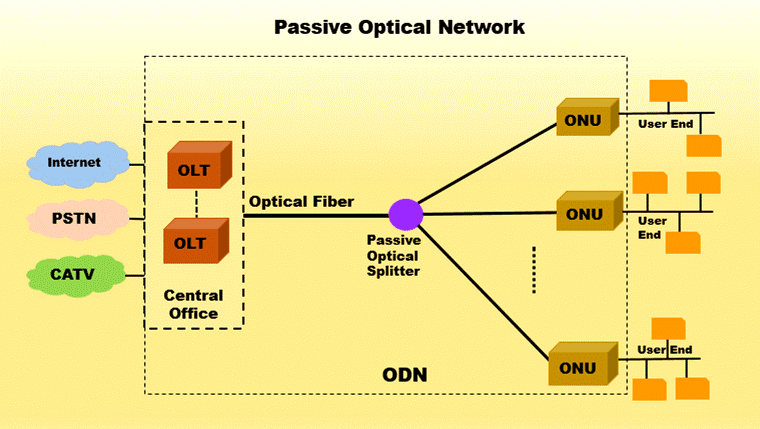Description

Disclaimer: Copyright infringement not intended.
Context
C-DOT, the premier Telecom R&D centre of the Department of Telecommunications (DoT), Government of India and Indian Institute of Technology, Kharagpur (IIT-K) signed an agreement for ‘Developing Prototypes for 10-Gigabit-capable symmetric Passive Optical Network (i.e., XGS-PON) Optical Line Terminal (OLT) and Optical Network Unit (ONU).
Details
- The agreement is signed under the Telecom Technology Development Fund (TTDF) scheme of Department of Telecommunications.
About Optical Networks
- Definition: Optical networks, also known as fiber-optic networks, utilize light signals to transmit data over long distances with high speed and bandwidth.
- Importance: Optical networks form the backbone of modern telecommunications, supporting various services such as internet connectivity, telephone communication, video streaming, and cloud computing.
Architecture:
- Optical Fiber: The core component of optical networks is the optical fiber, a thin, flexible strand of glass or plastic that carries light signals over long distances.
- Optical Transceivers: Optical transceivers are devices used to convert electrical signals from network equipment into optical signals for transmission over the fiber, and vice versa.
- Optical Amplifiers: Optical amplifiers boost the strength of optical signals to compensate for signal loss over long distances, ensuring reliable transmission.
- Multiplexing and Demultiplexing: Multiplexing techniques such as wavelength division multiplexing (WDM) allow multiple optical signals to be transmitted simultaneously over a single fiber, increasing bandwidth capacity.
Components:
- Optical Switches: Optical switches route optical signals through the network, enabling dynamic allocation of bandwidth and efficient traffic management.
- Optical Cross-Connects (OXC): OXCs are devices used to interconnect multiple optical fibers, allowing for flexible routing and switching of optical signals within the network.
- Optical Add-Drop Multiplexers (OADM): OADMs enable the insertion or extraction of specific optical signals at intermediate points in the network, facilitating flexible network configurations.
Applications:
- Telecommunications: Optical networks form the backbone of telecommunications infrastructure, providing high-speed internet access, voice communication, and video conferencing services.
- Data Centers: Optical networks are widely used in data centers for interconnecting servers, storage systems, and networking equipment, enabling fast and reliable data transfer between devices.
- Cable Television (CATV): Optical networks are used in cable television distribution systems to deliver high-definition video content to subscribers over fiber-optic cables.
- Mobile Backhaul: Optical networks play a crucial role in mobile backhaul, connecting cellular base stations to the core network and supporting the increasing demand for mobile data services.

About optical fibre cables
- Definition: Optical fiber cables are thin, flexible strands made of glass or plastic, designed to transmit light signals carrying data over long distances.
- Importance: Optical fiber cables form the backbone of modern telecommunications infrastructure, supporting internet connectivity, telephone communication, cable television, and data transmission in various industries.
Construction:
- Core: The core is the central part of the optical fiber through which light travels. It is made of ultra-pure glass or plastic with high optical transparency.
- Cladding: Surrounding the core is the cladding, a layer of material with a slightly lower refractive index than the core. The cladding helps confine light within the core by promoting total internal reflection.
- Buffer Coating: The buffer coating provides mechanical protection to the fiber and helps prevent damage from bending or stretching. It is typically made of a durable polymer material.
- Outer Jacket: The outer jacket provides additional protection against environmental factors such as moisture, abrasion, and temperature variations. It is made of a rugged material such as polyethylene or PVC.
Working Principle:
- Total Internal Reflection: When light enters the core of an optical fiber at a certain angle, it undergoes total internal reflection at the core-cladding interface, allowing it to propagate through the fiber without significant loss.
- Modulation: Data transmission is achieved by modulating the intensity or phase of the light signal. Binary data is encoded into the light signal using techniques such as on-off keying (OOK) or phase shift keying (PSK).
- Multiplexing: Multiplexing techniques such as wavelength division multiplexing (WDM) allow multiple data streams to be transmitted simultaneously over a single optical fiber by using different wavelengths of light.
Types of Optical Fiber Cables:
- Single-mode Fiber: Single-mode fibers have a small core diameter, allowing only a single mode of light to propagate. They are used for long-distance communication and high-bandwidth applications.
- Multimode Fiber: Multimode fibers have a larger core diameter, allowing multiple modes of light to propagate. They are commonly used for shorter-distance communication within buildings and campuses.
- Plastic Optical Fiber (POF): POFs are made of plastic instead of glass and are less expensive and more flexible than traditional optical fibers. They are used in applications such as automotive networking and home networking.
Advantages:
- High Bandwidth: Optical fiber cables offer significantly higher bandwidth compared to traditional copper cables, enabling faster data transmission over longer distances.
- Low Attenuation: Light signals experience minimal loss (attenuation) as they propagate through optical fiber cables, allowing for longer transmission distances without the need for signal amplification.
- Immunity to Electromagnetic Interference: Optical fiber cables are immune to electromagnetic interference, making them ideal for use in environments with high electrical noise levels.
- Security: Optical fiber cables are difficult to tap or intercept, providing a higher level of security for data transmission compared to traditional copper cables.

Conclusion
Optical networks are the backbone of modern telecommunications, providing high-speed, reliable connectivity for a wide range of applications. By leveraging innovations in optical components, network architecture, and transmission technologies, optical networks will remain at the forefront of telecommunications infrastructure, enabling the realization of a connected and digitally empowered society.
|
PRACTICE QUESTION
Q. Optical fiber cables are a cornerstone technology in modern telecommunications, offering high-speed, reliable, and secure data transmission for a wide range of applications. Comment. (15 marks)
|
















